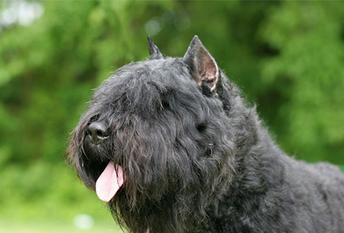Show grooming a Black Russian is an involving task, but household Russians have it a lot easier. Regular, weekly brushing will keep the coat healthy, manageable and free from tangles or mats. This breed does not shed heavily, but if you find clumps of hair around the house, it's an indication that the dog is not being brushed enough.
They need to be clipped twice a year, but it is simple to clip this breed at home, and a professional groomer is not required. Blackies only need to be bathed as needed, as over bathing can dry out the skin and coat. The beard can require a bit more attention, as it gets wet, dirty and tangled from food and water dishes.
Regular brushing of the teeth can keep gums healthy, prevent tartar buildup and stave off “dog breath.” The ears should be cleaned regularly, as well, to prevent harmful bacteria from building up and causing ear infections.
The Black Russian Terrier needs at least 30 or 40 minutes ofexerciseevery day. He is eager to take part in brisk walks, long runs, bike rides, swims, and hikes with his owner. In the backyard, he and his owner can play with a ball or a flying disc.
A BRT who doesn’t get enough exercise will become unhappy and destructive, and one who doesn’t spend enough time with his human family can develop aggressive tendencies. Many BRTs excel at canine sports such asobedience,agility,rally, and Schutzhund (protection) competitions.
Black Russian Terriers should be fed on 3.5-4 cups of high-quality dog food divided into two meals a day.
Any diet should be appropriate to the dog’s age (puppy, adult, or senior). Some dogs are prone to gettingoverweight, so watch your dog’s calorie consumption and weight level.Treatscan be an important aid in training, but giving too many can cause obesity.
Learn about whichhuman foodsare safe for dogs, and which are not. Check with your vet if you have any concerns about your dog’s weight or diet.Clean, fresh water should be available at all times.
The Black Russian Terrier is typically a healthy breed, and aresponsible breederwill screen breeding stock for health conditions such as allergies, urinary tract stones, hip and elbow dysplasia, and progressive retinal atrophy, which can cause vision loss and blindness.
As with all breeds, aBlack Russian Terrier’s earsshould be checked regularly, and theteethshould be brushed regularly.
Black Russian Terriers are extremely intelligent and eager to please and are fairly easy to train. They do however have strong personalities and should be handled with a loving but firm hand from an early age.
BRT puppies are inquisitive and playful and some adults too display this extreme curiosity. Black Russian Terriers often excel at various obedience competitions and dog sports such as agility and Schutzhund training.











